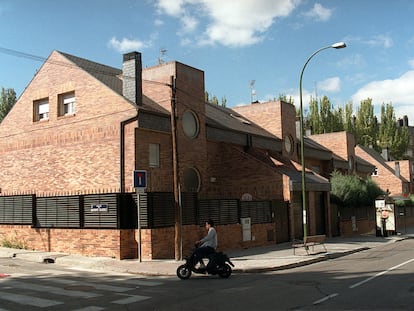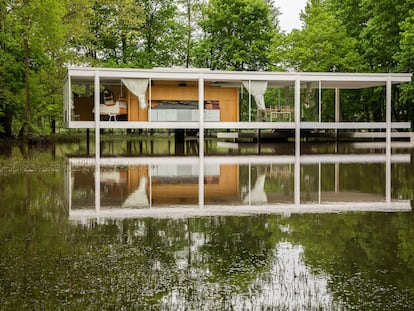From Nazi pipe dreams to urban green oases: The politics of architecture
Who benefits from classical domes and columns: democratic or totalitarian regimes? What about Brutalist concrete: capitalism or communism, the rich or the poor? And, above all, why is urban regreening an ideological issue?
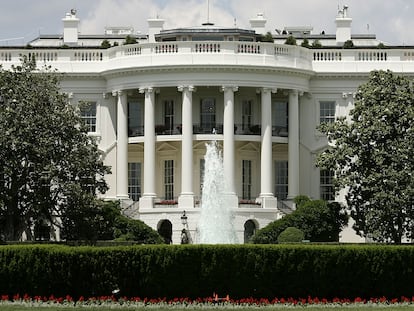
If we have learned anything from being immersed in a constant electoral campaign, it is that politics permeates everything: there is nothing that escapes the partisan double-talk that candidates repeat like trained parrots. It matters little that there are certain matters of universal interest for which a healthy democratic society should pull in the same direction. We have chosen conflict. Everything is a debate. Everything is ideology. “Everything is politics,” said Thomas Mann.
What about architecture? Is it political? Does it have an ideology? Buildings are governed by their own laws — construction, function and beauty, although this debate is complicated — not by ideological strategies. They do not establish fiscal frameworks for the redistribution of wealth, enact laws to combat climate change, or declare war on a neighboring country. It is our leaders who make those decisions. Although it may seem that architecture is at the service of a certain political regime, that does not necessarily make buildings politicized objects.
For example, the classical architecture of Ancient Greece has served as a model both for buildings aspiring to represent popular sovereignty (the Capitol in Washington, the Palace of Congress in Madrid or the Bourbon Palace in Paris, seat of the National Assembly of France), and for the unhinged project that Adolf Hitler and Albert Speer devised for the renovation of Berlin.
Something similar happened with the brutalist architecture of the 1960s and 1970s. In the United States it is commonly seen in federal buildings, while on the other side of the former Iron Curtain it is deployed in a mind-boggling legacy of monuments and public buildings designed to glorify Soviet tutelage. In the United Kingdom, brutalism was expressed in large social housing complexes. In Spain, however, this architecture was chosen for the fortunate families who could afford a house in the Torres Blancas, by Francisco Javier Sáenz de Oíza, or a large flat overlooking the Retiro park in the Torre de Valencia, by Javier Carvajal.
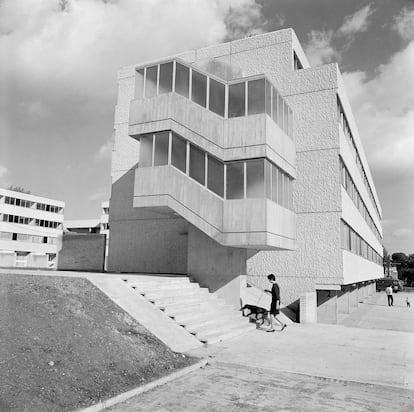
Who is served, then, by classical pediments, domes, friezes and columns? Democrats or Nazis? What about brutalist concrete? Capitalism or communism? The rich or the poor? All these examples seem to lead to the same answer: no one.
However, the fact that a building cannot be ascribed an ideological meaning does not mean that the act of designing it does not obey a professional ethic that, in a way, is quite similar to the way in which governments manage public affairs. Frank Lloyd Wright ran his studio as a cult and operated a regime of semi-slavery that allowed him to produce some of the greatest architectural creations of the twentieth century. Without this sinister model, neither the Fallingwater house nor the Guggenheim Museum in New York would exist. Of course, Wright was not the only one, and in the 21st century, this practice is still going on. Architects and univesity lecturers José María Echarte and David García-Asenjo have reflected on how the teacher-disciple dynamic fuels job insecurity in architectural firms. The complaint from students and young architects is the same over and over again: Draconian schedules, meager salaries, sine die interns, and bogus self-employed status.
From the first sketches to the last detail, from choosing materials to managing a project, the process of designing architecture requires many decisions with an unquestionable political and social impact. The stadiums in which the FIFA World Cup Qatar 2022 was played were endorsed by some of the most prestigious architectural firms in the world, such as Zaha Hadid Architects and Foster + Partners, who contributed to the tournament with spectacular designs that reinterpreted the Qatari tradition with an avant-garde twist. No one knows exactly how many migrant workers died during their construction — the emirate acknowledged 400, while The Guardian raised the figure to 6,500 — but on this side of the world the condemnation was unanimous: building in such conditions is intolerable. The debate over whether a building can be good even if it serves evil ends and whether architects should atone for the sins of their clients remains an open issue.
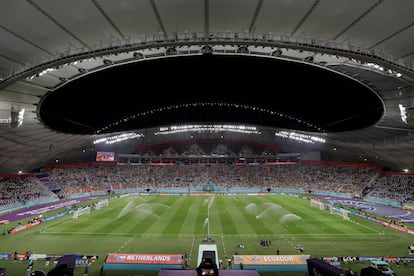
Of course, there are also many studios and associations that understand architecture as a “loaded weapon of the future” — as Gabriel Celaya would say — and conduct their professional activities with a conscious, positive militancy. Sometimes they even win the battle. When Francis Kéré was awarded the prestigious Pritzker Prize in 2022, many did not understand that the Nobel Prize for architecture was awarded to an architect whose work was mainly based on discreet earthen community buildings built in a village in his native Burkina Faso. Certainly, its architecture is not as spectacular as that of the select club of the international Star System to which Frank Gehry, Rem Koolhaas, Jean Nouvel, and Herzog & de Meuron belong. But Kéré is an example of the opposite. His commitment to the climate and landscape of the site, to material tradition and production costs, to the society for which his buildings are intended and to the workers who build them, is genuinely revolutionary. His way of doing architecture is a political act.
Let’s look at Spain. Just look at any media: architecture and urban planning have burst into the current political debate like a bull in a china shop. It was astonishing to see how the recent proposal to redesign our cities following what Carlos Moreno has christened the 15-minute city was received. The hostility from a significant part of the population, during election periods, was particularly irritable. Promoting measures aimed at enabling the public to carry out their daily personal, work and leisure routine without the need for public transportation or their own vehicle was interpreted as an attack on individual rights and liberties. Against all odds, the revival of traditional neighborhood life had been transformed into a totalitarian solution that would make George Orwell’s 1984 character, Big Brother pale.
The same is true of proposals for regreening cities. “The surge in research on the benefits of nature suggests that urban green space should not be considered an optional luxury. It is a fundamental part of a healthy human habitat, and therefore daily exposure is essential,” says Charles Montgomery in Happy City (Captain Swing, 2023) a stimulating essay on how the city design can contribute to our well-being not only physically, but also psychologically. “If we don’t see it or touch it, nature can’t do us much good.” However, mayoral campaigns in cities such as Madrid and Barcelona have twisted the arguments to the point of trying to convince voters that wanting a healthier city is not science, but ideology. And worst of all, they are succeeding. The accusations traded between climate deniers and climate hysterics (to use their terms) have degraded the quality of the debate to subterranean levels, and now a part of the populace does not seem to want to accept changes in urban planning or architecture concerning health just because they come from a certain political viewpoint.
Reducing meat and alcohol consumption — and putting an end to their industrial production, which is bad for animals and humans — attacking smoking and encouraging people to do sports should be understood as measures aimed at improving people’s health and their lives without any kind of partisan bias. And so should the intention to live in healthier cities. Unfortunately, the most incapable politicians are perfectly capable of muddying everything. We see it all the time with the superblocks that (mayor of Barcelona) Ada Colau has promoted in her city. The model may be debatable on some technical issues — as its political and media rivals are keen to emphasize — but what is beyond dispute is that it is a proposal that addresses the devastating effects of climate change in large metropolises. Planting more trees in streets, squares and gardens, providing them with permeable soils capable of retaining rainwater, returning public space to pedestrians and bicycles, and taking it away from private motorized vehicles, should not be considered a political act of courage, but of strict common sense.
If there are other better proposals — and we are not referring to putting flower pots on balconies — the public wants to hear them. And vote for them, of course. Because in the end and as much as it pains us, it seems that everything is indeed politics.
Sign up for our weekly newsletter to get more English-language news coverage from EL PAÍS USA Edition
Tu suscripción se está usando en otro dispositivo
¿Quieres añadir otro usuario a tu suscripción?
Si continúas leyendo en este dispositivo, no se podrá leer en el otro.
FlechaTu suscripción se está usando en otro dispositivo y solo puedes acceder a EL PAÍS desde un dispositivo a la vez.
Si quieres compartir tu cuenta, cambia tu suscripción a la modalidad Premium, así podrás añadir otro usuario. Cada uno accederá con su propia cuenta de email, lo que os permitirá personalizar vuestra experiencia en EL PAÍS.
¿Tienes una suscripción de empresa? Accede aquí para contratar más cuentas.
En el caso de no saber quién está usando tu cuenta, te recomendamos cambiar tu contraseña aquí.
Si decides continuar compartiendo tu cuenta, este mensaje se mostrará en tu dispositivo y en el de la otra persona que está usando tu cuenta de forma indefinida, afectando a tu experiencia de lectura. Puedes consultar aquí los términos y condiciones de la suscripción digital.
More information
Archived In
Últimas noticias
Maduro counterattacks Trump with rhetoric and announces downing of nine drug trafficking aircraft
‘Ecce Homo’: The miraculous disaster that made a small Spanish town famous
Return to sex testing at the Olympics: IOC edges closer to banning transgender women
Trump escalates conflict with Venezuela with the start of covert operations
Most viewed
- Sinaloa Cartel war is taking its toll on Los Chapitos
- Oona Chaplin: ‘I told James Cameron that I was living in a treehouse and starting a permaculture project with a friend’
- Reinhard Genzel, Nobel laureate in physics: ‘One-minute videos will never give you the truth’
- Why the price of coffee has skyrocketed: from Brazilian plantations to specialty coffee houses
- Silver prices are going crazy: This is what’s fueling the rally

